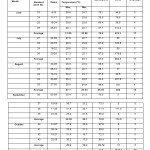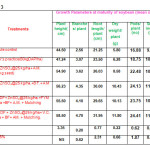Effect of Integrated Nutrient Management and Mulching on Growth and Yield of Soybean [Glycine Max (L.) Merrill] in Clay Loam Soil.
R.C. Jain1 *
1
Department of Agriculture,
Rafi Ahmed Kidwai college of Agriculture,
Sehore,
466001
M.P.
India
DOI: http://dx.doi.org/10.12944/CWE.10.2.40
The present experiment was laid out in a randomized block design consisted of 6 treatments. Taking the JS 95-60 as test variety in clay loam soil. Analysis of soil and plant samples was done as per standard methods.The present experiment was laid out in the field No.52 at Research Farm of R. A. K. College of Agriculture, Sehore (M.P.) during Kharif season, 2013 & 2014 The experimental site having fairly uniform topography with normal fertility status.
The effect of integrated nutrient management and mulching on plant height was noticed non significant. However , branches per plant, Root length/ plant (cm), Dry weight/ plant (g), Pods/plant(no), Seed index(g), and Grain yield(kg/ha) were found to increase significantly due to the application of 50% RDF + ZnSO4@25 kg/ha+ V.C. 1.5t/ha + B.F.+ A.M. + Mulching(T6) followed by treatment T4 and T5 ( Table 3) over other treatments. The such increase in soybean growth and yield was attributed to the increase in availability of nutrients with application of inorganic fertilizer.
Copy the following to cite this article:
Jain R. C. Effect of Integrated Nutrient Management and Mulching on Growth and Yield of Soybean [Glycine Max (L.) Merrill] in Clay Loam Soil. Curr World Environ 2015;10(2) DOI:http://dx.doi.org/10.12944/CWE.10.2.40
Copy the following to cite this URL:
Jain R. C. Effect of Integrated Nutrient Management and Mulching on Growth and Yield of Soybean [Glycine Max (L.) Merrill] in Clay Loam Soil. Curr World Environ 2015;10(2). Available from: http://www.cwejournal.org/?p=12556
Download article (pdf) Citation Manager Publish History
Select type of program for download
| Endnote EndNote format (Mac & Win) | |
| Reference Manager Ris format (Win only) | |
| Procite Ris format (Win only) | |
| Medlars Format | |
| RefWorks Format RefWorks format (Mac & Win) | |
| BibTex Format BibTex format (Mac & Win) |
Article Publishing History
| Received: | 2015-06-29 |
|---|---|
| Accepted: | 2015-08-06 |
Introduction
Soybean being a high protein and energy crop and its productivity is often limited by the low availability of essential nutrients or imbalanced nutrition farming is one of the important constraints to soybean productivity in India. Hence a balanced nutrients application is must to harness the potential productivity of the crop.Integrated nutrient management (INM) involves the use of manures, bio-fertilizers and chemical fertilizers to achieve sustained crop production and maintain better soil health. INM is best approach for better utilization of resources and to produce crop with less expenditure. Considering these points in view, the present study was initiated to know the “effect of integrated nutrient management and mulching on growth and yield of soybean [Glycine max (L.) Merrill] in clay loam soil”
Materials and Methods
The present experiment was laid out in a randomized block design consisted of 6 treatments. Taking the JS 95-60 as test variety in clay loam soil. Analysis of soil and plant samples was done as per standard methods.The present experiment was laid out in the field No.52 at Research Farm of R. A. K. College of Agriculture, Sehore (M.P.) during Kharif season, 2013 & 2014 The experimental site having fairly uniform topography with normal fertility status.
Climate and weather condition
Sehore is situated in the eastern part of the Vindhyan plateau in subtropical zone at the 27°12’ North latitude and 77°05’ East longitude at an altitude of 498.77m above mean sea level in Madhya Pradesh. The average annual rainfall varies from 1000-1200mm, concentrated mostly from June to September. The mean annual maximum and minimum temperature are 31.16 and 18.5 , respectively. The summer months are hot and May is the hottest month having maximum temperature up to 45.60 , winter months experienced mild cold with an average temperature from 16.56 to 8.74 . December is the coldest month as temperature reaches up to 1.0.
The weekly meteorological data viz. rainfall, temperature, relative humidity and no. of rainy days during crop season were recorded at meteorological observatory, R.A.K. College of Agriculture, Sehore. The meteorological data are presented in Table 3.1 and depicted in Figure 1.
It is evident from the data that rainfall pattern during the Kharif season of 2013 was not normal
Table 3.1 indicates that during the crop season total rainfall concentrated in 58 rainy days from June to October. The rainfall of 470.1 mm was received in the month of June in 17 rainy days with an average humidity of 70.6 per cent was recorded. The rainfall of 464.1 mm was recorded in 17rainy days in the month of July with an average relative humidity of 67 per cent. During August 482.0 mm rainfall was received in 16 rainy days with an average relative humidity of 66.66 per cent. While in September 113.5 mm rainfall was recorded in 3 rainy days with an average relative humidity of 70.8 per cent. During October 17 mm rainfall was received in 5 rainy days with an average relative humidity of 69.72 percent.
 |
|
The soil of the experimental field was clay loam in texture, fairly deep having a slight slope from west to east, which in turn provides good drainage.
To access the initial soil fertility status, soil samples to a depth of 0-30 cm were taken from randomly selected spots covering the entire experimental area with the help of soil augur before sowing. The samples thus collected were analysed for various chemical tests in the soil-testing laboratory of department of soil science and agricultural chemistry, college of agriculture, Sehore. The analysed values are presented in table 2: -
Physico- Chemical properties of experimental field
In order to find out the inherent fertility status of the experimental field, representative soil samples were collected from the experimental field. Soil samples were taken randomly with the help of auger up to a depth of 0-30 cm after the land preparation but prior to sowing of soybean. The samples were air dried, sieved through 2 mm sieve and used for chemical analysis. The initial soil samples were analysed as per standard procedures and contain the following status of available nutrients the available N was low (215.60 kg/ha),P was medium(16.5kg/ha),K was high(423.24kg/ha),and available S was Normal (10.2ppm). Therefore the recommended dose of fertilizer (RDF) were maintained on the basis of initial status of available nutrients in the experimental soil to carry out the present investigation. Accordingly as per RDF 20:60:20:20kg/ha each of nutrients nitrogen phosphorus, potassium and sulphur were applied.
Table 2: Chemical properties of experimental field
|
S. No. |
Particulars |
Content |
Level |
Method adopted |
|
1. |
Organic carbon (%) |
0.43 |
Medium |
Walkely and Black Method(1934) |
|
2. |
Available Nitrogen (N kg/ha) |
215.60
|
Low |
Modified alkaline Permanganate method (Subbiah and Asija 1956) |
|
3. |
Available Phosphorus (P2O5 kg-1) |
16.50
|
Medium |
Olsen’s extractant colorimetric method (Olsen’s et al., 1954) |
|
4. |
Available Potassium (K2O kg -1) |
423.24
|
High |
Neutral normal Ammonium acetate (Toth and Prince,1949) |
|
5. |
Available Sulphur (ppm) |
10.2 |
Normal |
Turbidimeteric Methods (Chesnin and Yien, 1951) |
|
6. |
Soil pH |
7.6 |
Normal |
By pH meter using 1:2.5 soil: water extract as described by (Jackson, 1973) |
|
7. |
Electrical conductivity (dSm1) |
0.32 |
Normal |
By conductivity meter as described by (Jackson, 1973 ) |
 |
Table 3 Click here to View table |
Results and Discussion
The effect of integrated nutrient management and mulching on plant height was noticed non significant. However , branches per plant, Root length/ plant (cm), Dry weight/ plant (g), Pods/plant(no), Seed index(g), and Grain yield(kg/ha) were found to increase significantly due to the application of 50% RDF + ZnSO4@25 kg/ha+ V.C. 1.5t/ha + B.F.+ A.M. + Mulching(T6) followed by treatment T4 and T5 ( Table 3) over other treatments. The such increase in soybean growth and yield was attributed to the increase in availability of nutrients with application of inorganic fertilizer, Therefore, continuous supply of macro and micro nutrients from vermicompost, in the soil was maintained which might helped in acceleration of various metabolic processes viz., photosynthesis, energy transfer reaction and symbiotic biological N–fixation process. And mineralization occurred and hence such response. However, these results are also in close agreement with the findings of Singh and Kumar(2012), and Konthoujam et al.(2013).
Conclusion
The application of 50% RDF + ZnSO4@25 kg/ha+ V.C. 1.5t/ha + B.F.+ A.M. + Mulching(T6) followed by treatment T4 and T5 was found to the beneficial for enhancing the soybean production in clay loam soil of M.P. ,India.
Acknowledgment
The author is very much and heart fully acknowledge Dr. A.K. SINGH, the Honorable VICE CHANCELLOR and Dr. H.S.YADAV, Director of Research Services, RVSKVV, Gwalior (M.P.) India, and the then Associate Director Research, ZARS, Khargone (M.P.), India for providing necessary facilities during the studies span.
References
- Chesnin, L. and Yien, C. (1951) Turbidimeteric determination of available sulphates. Soil Sci. Soc. of America Proceedings 15, 149-151.
- Jackson, M. L. ,(1973) Soil Chemical Analysis, Prentice Hall of India Pvt. Ltd., New Delhi.
- Konthoujam, N. D; Tensubam, B. S; Athokpam, H.S; Naorem, S. and Diana Shamurailatpam1 (2013) Influence of inorganic, biological and organic manures on nodulation and yield of soybean (Glycine max L. Merrill ) and soil properties. Australian J. Crop Sci. 7(9): 1407-1415
- Olsen, S.R., Cole, C.V. Watanabe F.S. and Dean ,L.A. (1954) Estimating of available phosphorus in soil by extraction with sodium bicarbonate USDA Circular., 939.
- Singh M., and Narendra Kumar (2012) Effect of FYM, vermicompost, vermiwash and NPK on growth, microbial biomass and yield of soybean. Soybean Res. 10:60-66.
- Subbiah, B.V. and G.L. Asija (1956) A rapid method for the estimation of available nitrogen in soil. Current (25): 259-260.
- Toth, S.J. and Prience, A.L.(1949). Estimation of CEC and exchangeable calcium , potassium and sodium contents of soil by flame photometer techniques .Soil Sci. 67:439-445.
- Walkley, A. and Black C.A. (1934) Estimation of soil organic carbon by the chromic acid titration method. Soil Sci. 37 (1): 29-38.







